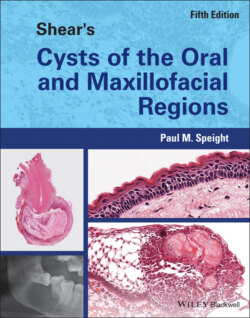Читать книгу Shear's Cysts of the Oral and Maxillofacial Regions - Paul M. Speight - Страница 75
Relationship of the Paradental Cyst to the Dentigerous Cyst
ОглавлениеAs discussed previously (see ‘Frequency’), there is evidence that some clinicians and pathologists do not recognise the paradental cyst as an entity, but rather regard it as a variant of dentigerous cyst. Ackermann et al. (1987 ) suggested that although the paradental cyst may arise from follicular (reduced enamel) epithelium, the histogenesis is quite different and it should not be regarded as a variant of dentigerous cyst. They believed that the dentigerous cyst should be defined as a cyst enclosing the crown of a completely unerupted tooth.
Despite this, many clinicians and pathologists diagnose collateral lesions associated with partially erupted third molars as ‘inflamed dentigerous cysts’. Fowler and Brannon (1989 ) agreed with Ackermann et al. (1987 ) that a dentigerous cyst is, by definition, associated with an unerupted tooth, but also believed that the paradental cyst is a variant of dentigerous cyst. In this respect, a relationship to the dentigerous cyst may be suggested on the basis of a common origin from epithelium lining the dental follicle, with intraosseous (dentigerous cyst) and extraosseous (paradental cyst) variants associated with totally unerupted and partially erupted teeth, respectively.
One possible pathogenic mechanism for the paradental cyst is that it represents a developmental dentigerous cyst that has become laterally (and buccally) displaced by the eruption of the associated tooth, with subsequent inflammation. This seems unlikely, however, since the typical radiology of the paradental cyst (see Figures 4.2 and 4.5a) suggests that the dental follicle remains intact and is not dilated, and such a mechanism would not explain the consistent buccal location. An alternative proposal is that the paradental cyst is simply an inflammatory type of dentigerous cyst that arises as a result of inflammation of the pericoronal tissues surrounding the partially embedded crown of an impacted or erupting tooth. This would be a perfectly acceptable proposal, but for the fact that an inflamed and expanded pericoronal follicle would be indistinguishable from pericoronitis associated with inflammatory osteolysis. Yet paradental cysts show a very distinctive radiology with a buccally orientated radiolucency that is quite distinct from an expanded dental follicle (see ‘Radiological Differential Diagnosis’ and Figures 4.2 and 4.5). For these reasons, we believe that inflammatory collateral cysts and dentigerous cysts show distinctive diagnostic features and should be designated as separate entities (Box 4.2).
